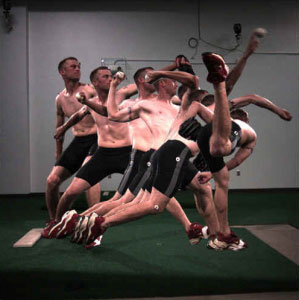 Pitching mechanics are critical when it comes to increasing pitching velocity. Hundreds of studies show the many correlations of certain pitching mechanics to increased pitching velocity. The problem is most coaches and players are unaware of these correlations and more importantly how to implement them. In the 3X Pitching Velocity Program I have mapped out over 40 pitching mechanics components with reference to scientific research proving the correlation to the high-velocity pitcher and have developed over 30+ 3X pitching drills to train the pitcher to implement these high-velocity components. In this article, I will pull out the top 5 pitching mechanics to increase pitching velocity from the soon-to-be legendary 3X Pitching Mechanics Guides.
Pitching mechanics are critical when it comes to increasing pitching velocity. Hundreds of studies show the many correlations of certain pitching mechanics to increased pitching velocity. The problem is most coaches and players are unaware of these correlations and more importantly how to implement them. In the 3X Pitching Velocity Program I have mapped out over 40 pitching mechanics components with reference to scientific research proving the correlation to the high-velocity pitcher and have developed over 30+ 3X pitching drills to train the pitcher to implement these high-velocity components. In this article, I will pull out the top 5 pitching mechanics to increase pitching velocity from the soon-to-be legendary 3X Pitching Mechanics Guides.
The Foundation of High-Velocity Pitching Mechanics
At the core of the high-velocity pitcher is the high-speed athlete or the power athlete. If you remove the athlete from the power pitcher then you lose the power and all you have is the pitcher. The biggest misconception is that if you can just replicate the mechanics of the high-velocity pitcher then you will become a high-velocity pitcher. That is easier said than done! The problem is this isn't the entire equation. This is like saying if I just dress and look like a movie star then I will become a movie star. Not exactly right?
It isn't enough to cognitively understand the movement of the high-velocity pitcher. The only way you can get your central nervous system to capture the movement pattern for autonomous replication is if you can actually recreate the movement. When working to recreate the high-velocity mechanics you need to do two things. You need to not only hit the key position as listed below in the top 5 pitching mechanics to increase velocity but you have to hit these positions at the exact times as listed below with the same amount of force as well. The challenge to timing these positions and applying enough force is having the athletic ability to do so. This means you must have the strength and speed of the average high-velocity pitcher. There isn't that much data out there recording the average speed and strength of the high-velocity pitcher but we do have it for the average professional baseball player and it is eye-opening information. You can learn more about this performance data of the professional baseball player in my article called, Holy Grail Study Proves MLB Players Produce More Vertical Power.
Conventional Pitching Mechanics
The high-velocity pitching mechanics listed below will be completely foreign to you because you have been corrupted by the conventional wisdom of the game. I say corrupted because you have been brainwashed to believe that movements like slow short strides or long follow-throughs with the throwing arm are the correct way to pitch. I say brainwashed because these conventional pitching mechanics have been programmed into your brain as muscle memory and for you to learn better motor coordination it will take a complete reset of your motor coordination to develop these new movements. The 3X Pitching Velocity Program will reset this old motor coordination to make way for the new by using the 3X drills to put you into unfamiliar and uncomfortable positions and movements so your brain doesn't slip back into the comfort zone of its old ways of throwing the ball. The biggest challenge of the program is surviving this transition into the new movement patterns and programming them into your new motor coordination.
Top 5 Pitching Velocity Mechanics
These pitching velocity mechanics listed below come from the 3X Pitching Mechanics Guides which are included in the 3X Pitching Velocity Program. You may not fully understand these mechanics below initially but as you continue to research and learn from this site you will soon develop a complete understanding of the high-velocity pitcher.
- Separation Timing - Separation-Timing is the measurement of the moment of peak hip rotation to peak shoulder rotation. The moment from front foot strike to pitch release is defined as the Throwing Phase in the 3X Pitching Mechanics. In the measurement of Separation-Timing, this component exists at the beginning of the Throwing Phase which is segmented into percentages. The entire phase is equal to 100%. Studies state that the high-velocity pitcher peaks hip rotation at 27-35% of this phase. They then peak shoulder rotation at 47-60% of this phase (1,2). This produces a margin of Separation-Timing around 20-25%. Low-velocity pitchers on average have a margin of Separation-Timing around 17%. Studies show that some of the low-velocity pitchers were just peaking at hip rotation speeds 48% into the Throwing Phase (2).
- Triple Extension (3X) - This is the foundation of the revolutionary approach to increase pitching velocity called, 3X Pitching. This component coupled with hip-to-shoulder separation is the secret to high-velocity pitching. 3X is the extension of the ankle, knee, and hip flexor just before the front foot strike. If fully implemented at the perfect time and with explosive power then the hips will rotate at a higher rate just following the front foot strike which is linked to the high-velocity pitcher (8). The challenge of this component is the timing factor along with the power production requirements but if implemented effectively, hip-to-shoulder separation is enhanced which will significantly increase pitching velocity (9). Triple Extension & Separation is not the only way to increase pitching velocity in the pitcher delivery, but it is the most effective 3X Component when trying to improve pitching velocity significantly. Studies have also proven the correlation between leg drive or 3X and wrist velocities which is more scientific proof that 3X is the key to significantly increasing pitching velocity (10).
- 3X Ankle Kick - This is a critical final part of achieving triple extension (3X). Achieving the 3X Ankle Kick before the front foot strike is the elite move in the 3X Pitching Mechanics. Studies have shown that the muscle activation of the calf muscle (Gastrocnemius) is the highest of all the drive leg muscles during the stride in the high-velocity pitching delivery (3). The calf muscle is what extends or kicks the ankle. Studies have also shown this muscle activation to peak just at the front foot strike (3). Studies have also shown that ground reaction forces peak following the same rate of this muscle activation and linear wrist velocity at ball release correlated highly with maximal push-off forces (4,5). It is obvious the links to the ramping of the muscle activation in the drive leg muscles, especially the calf muscle through the 3X Ankle Kick, to ground reaction forces and pitching velocity.
- Force Vector - This component along with Triple Extension (3X) was first introduced into the pitching mechanics world at www.TopVelocity.net. Both these terms come from the Olympic Lifting world and they are key components of power athletes. If 3X is the power component of the power athlete, then The Force Vector is the component that guides this power. The Force Vector is exactly what each word describes, it is the force direction or direction of the force. In the case of the pitcher, the only part of the body that can build force is the part that is in contact with the ground. It is called ground reaction forces and the two parts of the body that can create it are the drive leg and the landing leg. The Force Vector of each leg is the direction of the ankle to the knee. These joints guide this force into the hips. The Force Vector is so critical to pitching because a pitcher can not build power with the drive leg until it is in a linear position towards the target. The majority of low-velocity pitchers never achieve a linear Force Vector during the stride. This means they do not implement the power component of 3X as well. This is why these pitchers fall into the low-velocity category.
- Front Leg Extension (2X) - Studies have shown that high-velocity pitchers get more 2X at pitch release than low-velocity pitchers (6). It is called 2X because the ankle and knee of the front leg move into extension as the hip flexor stays in flexion. When the pitcher first lands at Front Foot Strike and stabilizes the front leg, the lower half is building more ground reaction forces. Studies have shown that high-velocity pitchers are resisting, with the front leg, around 170% of their maximal voluntary isometric contraction (7). If the pitcher can stabilize and then drive and extend this leg back into the hips, this will transfer more power into the upper kinetic chain increasing pitching velocity. It is important to remember that The Force Vector of the front leg must also be in a more linear position before this leg drives just like The Force Vector of the drive leg. A good rule of thumb is to keep the front knee behind the heel during this 2X.
Learn all of the 40+ pitching mechanics to increase pitching velocity in the 3X Pitching Velocity Program. You will also have access to the 3X Programs which include all of the 3X drills needed to implement these high-velocity pitching mechanics into your pitching delivery.
The #1 BioMechanics Velocity Training Program
 This program has helped tons of pitchers live the dream of throwing 90+mph and signing with a D1 University, getting drafted by a Major League Organization, and making it back to Major League Baseball. Many scouts in all organizations of baseball have recommended this program to help young pitchers get to the 90+mph range to improve their value at the next level.
This program has helped tons of pitchers live the dream of throwing 90+mph and signing with a D1 University, getting drafted by a Major League Organization, and making it back to Major League Baseball. Many scouts in all organizations of baseball have recommended this program to help young pitchers get to the 90+mph range to improve their value at the next level.
The reason the 3X Extreme Pitching Velocity Program works is that it is based on science and it has been proven to develop the 90+mph fastball on thousands of pitchers. It isn't rocket science or voodoo, it is the real deal! The program comes with a high-level workload of drills, lifts, and exercises scientifically programmed to enhance throwing speed on the mound while developing an efficient pitching delivery. The format of the 3X Pitching Velocity Program is similar to the same approach Olympic throwers have been using for decades to increase throwing velocity. This approach isn't new to the sports world but it is new to baseball.
If you are serious about your career and are insanely driven to put yourself into an extremely small percentage of pitchers who are potential D1 prospects, top level draft picks or you just want to reach your potential on the mound then this program is the best chance you have to make your dreams come true.
Learn more about the 3X Extreme Pitching Velocity Program or get started TODAY by adding 5-10+mph!

Pitching Mechanics Reference
- Baseball Pitching Biomechanics in Relation to Injury Risk and Performance - Dave Forten- baugh, MS, Glenn S. Fleisig, PhD,* and James R. Andrews, MD. - Sports Health. 2009 July; 1(4): 314–320.
- Anthropometric And Performance Comparisons In Professional Baseball Players - Hoffman JR, Vazquez J, Pichardo N, Tenenbaum G. - Department of Health and Exercise Science, The Col- lege of New Jersey, Ewing, New Jersey, USA. - J Strength Cond Res. 2009 Nov;23(8):2173-8.
- Lower extremity muscle activation during baseball pitching - Campbell BM, Stodden DF, Nixon MK. - J Strength Cond Res. 2010 Apr;24(4):964-71.
- Characteristic Ground-reaction Force In Beginner Baseball Pitching - JChun-Lung Lin, Chung-Yu Chen, Hong-Wen Wu, Chen-Fu Huang. - Department of Physical Education, National Taiwan Normal University, Taipei, Taiwan, Graduate School of Physical Education, National Taiwan Col- lege of P.E., Taichung, Taiwan, Department of Sports Medicine, China Medical University, Taichung, Taiwan.
- Characteristic ground-reaction forces in baseball pitching - MacWilliams BA, Choi T, Perezous MK, Chao EY, McFarland EG. - Department of Orthopaedic Biomechanics, Johns Hopkins University, Baltimore, Maryland, USA. - Am J Sports Med. 1998 Jan-Feb;26(1):66-71.
- Kinematic Differences Between Highly-skilled And Less-skilled Baseball Pitchers - Glenn S. Fleisig1, Tomoyuki Matsuo2, Rafael F. Escamilla3, Steve W. Barrentine1, and James R. Andrews1 - 1. American Sports Medicine Institute, Birmingham, Alabama - 2. School of Health & Sports Sciences, Osaka University, Osaka, Japan - 3. Department of Surgery, Duke University, Durham, North Carolina.
- Lower extremity muscle activation during baseball pitching - Campbell BM, Stodden DF, Nixon MK. - J Strength Cond Res. 2010 Apr;24(4):964-71.
- Kinematic Comparisons Of Different Pitch Velocity Groups In Baseball Using Motion Model Method - Keizo Takahashi1, Norihisa Fujii2, and Michiyoshi Ae2, - Doctoral Program in Health and Sport Sciences, University of Tsukuba, Japan. - Institute of Health and Sport Sciences, University of Tsukuba, Japan.
- NPA Velocity Study conducted 2005-2006 - Tom House, PhD - The National Pitching Association.
- Biomechanical analysis of forearm pronation and its relationship to ball movement for the two-seam and four-seam fastball pitches - Keeley DW, Wicke J, Alford K, Oliver GD. - Department of Health Science, Kinesiology, Recreation and Dance, University of Arkansas, Fayetteville, Arkansas, USA. - J Strength Cond Res. 2010 Sep;24(9):2366-71.



